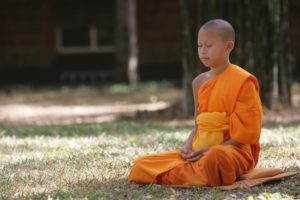Mindfulness
Insight Meditation:
Insight meditation or vipassana takes quite a different approach to that of calm or Samatha meditation. Whereas calm meditation is about concentrating the mind, insight meditation is about awareness of the present moment. A keyword used for this type of meditation is mindfulness’. One of the most important discourses of the Buddha was the one he gave on the Four Foundations of Mindfulness. The Buddha put a great deal of confidence in this meditation approach: this is the direct path for the purification of beings, for the surmounting of sorrow and lamentation, for the disappearance of pain and grief, for the attainment of the true way, for the realization of Nibbana. Unlike calm meditation, insight meditation is a method that takes the individual all the way to full enlightenment.
The Four Foundations of Mindfulness:
This very important discourse of the Buddha is divided into four sections with further subsections within two of those.
1. The Contemplation of the Body:
Mindfulness of Breathing:
This practice entails becoming aware of the breath, without any conscious effort to control it. The scriptures describe the procedure as follows:
“Here a monk, gone to the forest or to the root of a tree or to an empty hut, sits down; having folded his legs crosswise, set his body erect, and establishes mindfulness in front of him, ever mindful he breathes in, mindful he breathes out. Breathing in long, he understands, I breathe in long’; or breathing out long, he understands: I breathe out long’.”
This basic procedure is followed and the mind becomes tranquil. At this stage, the process is more or less the same as the breathing meditation of the calm meditation approach. The difference occurs when in observing the breath, there is an understanding of its impermanent nature, what the scripture refers to its ‘arising and vanishing factors’. This is where insight takes place as the meditator comes to a profound, experiential understanding of the impermanence that underlies all things. Such bare awareness also leaves no room for clinging’ which is about becoming attached to that which is pleasant and wishing to avoid that which is unpleasant. The mindfulness approach is about learning to see things as they really are without our subjective desires intruding.
The Four Postures:
Another meditation technique to do with the body is to bring bare awareness to the four postures identified by the Buddha as walking, standing, sitting and lying down. This practice involves making a mental note of the particular posture one is in, for example- ‘walking, walking, walking’, ‘or standing, standing, standing’. In fact, this practice extends to all waking activities: from brushing one’s teeth to defecating and urinating’!
Foulness – The Bodily Parts:
Certain meditation techniques, such as his one, aim to develop a certain degree of dispassion with regard to the body. The Buddhist attitude is to take care of the body and keep it healthy. It shouldn’t be mistreated or, at the other extreme, pampered. In this meditation, the practitioner is required to review – one by one of the parts that make up the body. Traditionally, Buddhism identifies thirty-two of these things as hair, sinews, vital organs, bodily fluids and so on. The practice involves comparing the body to a bag filled with different types of grain, such as hill rice, beans, peas, millet, and white rice.
Elements:
Similarly, the meditator can reflect on the body in terms of its four elements – earth, air, fire, and water. The bones, for example, belong to the earth elements; bodily gases belong to the air element; blood belongs to the water element and the heat involved in breaking down food in the digestive system relates to fire. The purpose is the same as the previous section to develop dispassion and objectivity in our understanding of the body.
Corpse Meditations:
During the Buddha’s time, monks would have gone to cemeteries and charnel grounds to perform this kind of practice. There are nine of these meditations in all, each one of which requires the practitioner to review bodies in various states of decay a skeleton without flesh and blood, for example, or a body disconnected and scattered. On the face of it this seems very morbid but the idea behind it is to destroy any illusions one might have about the body and its ultimate destiny.
2. The Contemplation of Feeling:
Another technique is to turn one’s attention to the feeling, noting whether a feeling is pleasurable, painful or neutral and to note how such feeling arises and vanishes and is therefore impermanent. Such feelings may be worldly’ (to do with the material world and satisfying the senses) or unworldly’ (those of a spiritual nature).
3. The Contemplation of Mind:
In this meditation the meditator is required to note the state of mind they are in whether it is infected with one or more of the three poisons’, greed, hatred and delusion, whether it is concentrated or diffuse, liberated or unliberated.
4. The Contemplation of Mental Objects:
This part of the discourse covers concepts relating to a wide gamut of the Buddha’s teachings:
The Five Hindrances:
The five hindrances are sensual desire, ill-will, sloth/torpor, worry/restlessness, and doubt. Here, the purpose is to note when these are present or absent and to note how they arise and vanish.
The Five Aggregates:
Here the meditator contemplates the five changing factors that make up the ‘self’ – body, feeling, perception, mental formations, and consciousness – the way they arise and the way they disappear and are therefore impermanent.
The Six Bases:
The focus here is on the senses (in Buddhism, the mind is seen as a sixth sense) and what they apprehend – sights, sounds, odors, flavors, tangible objects, and mind-objects, and how these too are subject arising and vanishing.
The Seven Enlightenment Factors:
Here the meditator is asked to note the presence or absence of the following enlightenment factors: mindfulness, investigation-of-states, energy, rapture, tranquillity, concentration, and equanimity.
The Four Noble Truths:
The focus here is on coming to a clear understanding of the first noble truth of suffering, the second noble truth of the origin of suffering, the third noble of the cessation of suffering and the fourth noble truth of the way leading to the cessation of suffering.
It is not necessary to practice all of these. It is likely that meditation on breathing and meditation on the four postures are the more widely practiced, followed by meditation on feeling and mental states, though it is difficult to quantify such observations.







